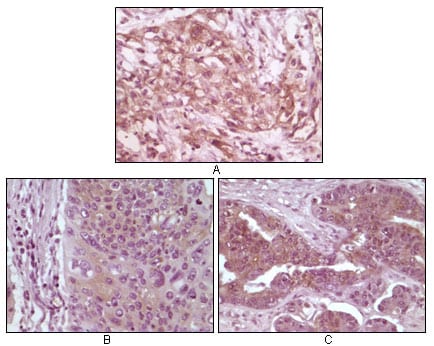
| WB | 咨询技术 | Human,Mouse,Rat |
| IF | 咨询技术 | Human,Mouse,Rat |
| IHC | 1/200 - 1/1000 | Human,Mouse,Rat |
| ICC | 技术咨询 | Human,Mouse,Rat |
| FCM | 咨询技术 | Human,Mouse,Rat |
| Elisa | 1/10000 | Human,Mouse,Rat |
| Aliases | BP-1; 4EBP1; 4E-BP1; PHAS-I; MGC4316; EIF4EBP1 |
| Entrez GeneID | 1978 |
| clone | 11G12C11 |
| Host/Isotype | Mouse IgG1 |
| Antibody Type | Primary antibody |
| Storage | Store at 4°C short term. Aliquot and store at -20°C long term. Avoid freeze/thaw cycles. |
| Species Reactivity | Human |
| Immunogen | Purified recombinant fragment of 4EBP1 expressed in E. Coli. |
| Formulation | Purified antibody in PBS with 0.05% sodium azide. |
+ +
以下是3-4条关于4E-BP1抗体的参考文献及摘要概括:
---
1. **文献名称**:*Regulation of 4E-BP1 phosphorylation: a novel two-step mechanism*
**作者**:Gingras, A.C., et al. (1998)
**摘要**:研究通过特异性抗体检测4E-BP1的磷酸化位点,揭示了mTORC1调控其磷酸化的两步机制,并证明不同磷酸化状态对eIF4E结合能力的动态影响。
2. **文献名称**:*mTOR signaling in growth control and disease*
**作者**:Proud, C.G. (2004)
**摘要**:综述总结了4E-BP1在mTOR通路中的核心作用,强调利用磷酸化特异性抗体揭示其在翻译起始调控及肿瘤中的异常激活机制。
3. **文献名称**:*Rapamycin suppresses 4E-BP1 phosphorylation through mTOR-independent mechanisms in cancer cells*
**作者**:Hara, K., et al. (1997)
**摘要**:通过Western blot和免疫沉淀(使用4E-BP1抗体),发现雷帕霉素可部分抑制4E-BP1磷酸化,提示存在mTOR非依赖途径的调控网络。
4. **文献名称**:*A unifying model for mTORC1-mediated regulation of mRNA translation*
**作者**:Thoreen, C.C., et al. (2012)
**摘要**:结合4E-BP1抗体和基因敲除实验,提出4E-BP1去磷酸化是mTOR抑制剂阻断帽依赖性翻译的关键步骤,为靶向治疗提供依据。
---
以上文献均利用4E-BP1抗体解析其功能或调控机制,涵盖基础机制到疾病应用研究。
The 4E-BP1 antibody is a crucial tool in studying the regulation of protein synthesis and cellular signaling pathways. 4E-BP1 (Eukaryotic Translation Initiation Factor 4E-Binding Protein 1) is a small regulatory protein that inhibits cap-dependent translation by binding to eIF4E, a key component of the translation initiation complex. This interaction is modulated by phosphorylation: when 4E-BP1 is hypophosphorylated, it tightly binds eIF4E, suppressing translation; phosphorylation by mTORC1 (mechanistic target of rapamycin complex 1) releases eIF4E, enabling ribosome recruitment to mRNA.
Research using 4E-BP1 antibodies focuses on its role in mTOR signaling, a pathway dysregulated in cancer, metabolic diseases, and aging. These antibodies detect 4E-BP1 expression levels and phosphorylation status (e.g., at Thr37/46 or Ser65 residues), providing insights into mTOR activity and cellular responses to nutrients, stress, or therapeutic agents like rapamycin analogs.
Commercial 4E-BP1 antibodies are widely used in techniques such as Western blotting, immunofluorescence, and immunoprecipitation. Specificity validation is critical, as cross-reactivity with other 4E-BP family members (e.g., 4E-BP2/3) may occur. Studies often pair total 4E-BP1 antibodies with phospho-specific versions to assess activation dynamics, linking translational control to processes like tumor progression, autophagy, and synaptic plasticity. Its role in cancer metabolism makes 4E-BP1 a biomarker for therapeutic targeting in oncology research.
×